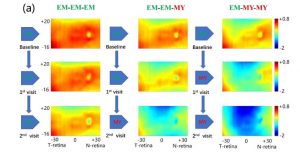Abstract
Purpose: To investigate the role of peripheral refraction in children’s myopization.
Methods: This 2-year study included 214 children (8–15 years old). Refraction across the retina (field of view: 60° × 36°) was measured with a custom-made aberrometer every year. Three datasets were established: dataset 1, 214 subjects from baseline to the first-year visit; dataset 2, 152 subjects from baseline to the second-year visit; and dataset 3, 59 initial emmetropes from baseline to the second-year visit. The baseline refraction of different retina regions was correlated with the central myopic shift, and was compared among groups with different levels of myopic shift.
Results: In datasets 1 and 2, the refraction distribution across the retina was significantly different among the subjects who were initially emmetropes but not among those who were initially hyperopic or myopic. Refraction in the central vertical retina, especially in the superior retina (r = −0.5, P < 0.001), was significantly correlated with the myopic shift for emmetropes in that subjects with more relative myopia in the superior retina manifested greater central myopic shifts. In dataset 3, 21 subjects remained emmetropic after 2 years, 15 subjects became myopic at the 1-year visit, and 23 subjects became myopic at the 2-year visit. No difference was found for the relative peripheral refraction in all of the peripheral regions between the stage prior to and after the onset of myopia.
Conclusions: Relative myopic defocus in the superior retina could be a predictor of central myopia shift. Changes in relative peripheral refraction are more likely a consequence of myopia progression rather than a cause.
Doi: doi.org/10.1167


